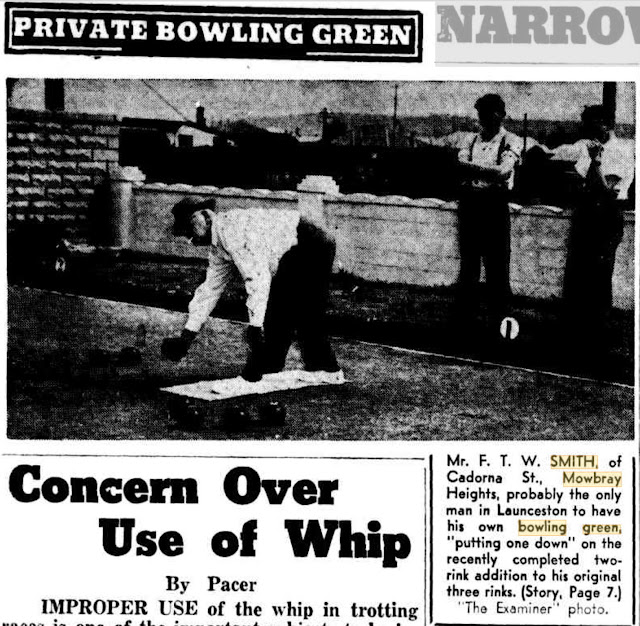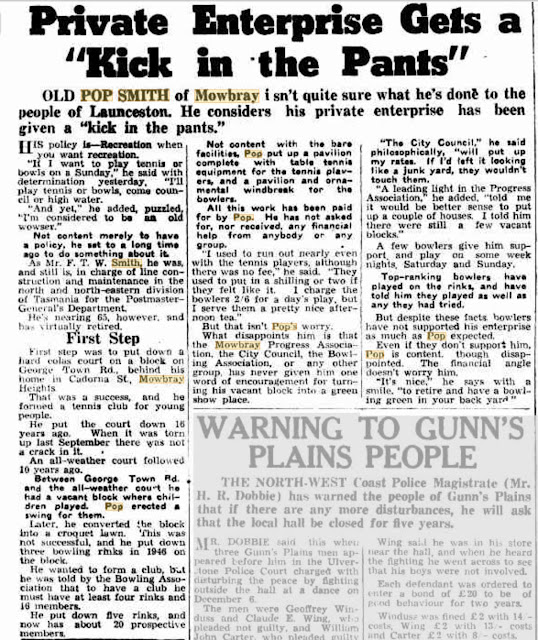 |
FTW Smith, Mowbray
The Examiner, Launceston, 17 Feb 1950 |
When I was a teenager I sat down with my grandfather, Duncan Smith, and asked him to name all of his cousins. As he did so I wrote them all down and since then his list has proven to be accurate, including the order of births. What is amazing to me is that he had 69 cousins (as well as 7 siblings).
One of his cousins was Frederick Thomas Walker Smith. My grandfather told me that Fred lived in Tasmania and a son was killed on a ship in the Second World War.
So I set out to do a search on the newspapers at Trove and as a result I now know quite a bit more about cousin Fred.
The article above, and numerous other reports, told me that Fred (known as Pop) was a very keen lawn bowler. So keen in fact, he built his own bowling green but was disappointed that when he didn't get many players keen to play on his green.
 |
| The Examiner, Launceston. 17 Feb 1950 |
In 1950 Fred also retired from his job as chief line inspector in Northern Tasmania for the PMG having worked for the department for 42 years. He appears to have been well respected.
 |
| FTW Smith retires. Examiner, Launceston, 14 Jul 1950 |
By my calculations that means he started work as a linesman in about 1908 at the age of about 22. Fred was born in Dunmunkle near Minyip, Victoria in 1885. His parents were Sampson Smith and Elizabeth Walker who were farmers. His parents later moved to Caramut where they had a shop. Fred had nine brothers and sisters.
In 1917 Fred's father died and later that year Fred was employed to help install the first telephone lines on King Island in Bass Strait.
Telephones.— For many years the establishment of a telephonic system on the island was considered by the majority here more or less in the light of a harmless vision, the materialisation of which was not only considered but its utility,
even if possible of realization, was greatly questioned, it being contended that even if such a system was in existence it would only be used on rare occasions, and other arguments of an equally convincing nature to those maintaining them. An idea of the value of this last named argument may be gained by anyone
frequently visiting the post office where at any time of the day from morn to dewy eve, and later, the system may be heard and seen in constant operation. In all innovations there is always a minority who, by virtue of possessing some imagination, are enabled to see a little further ahead than others, and the matter under consideration was no exception to the invariable rule, as it is now many years since tentative efforts were made by the few in the direction of bringing the matter within the realm of actual fact. As this has now been accomplished, the believers and their efforts and the disbelievers and their witticisms having became matters of ancient history recorded in these pages and elsewhere, it is needless to make further reference to them except to say that their efforts for and against, the scheme constitute a rather interesting and instructive chapter in the historical development of the island. Coming to the actual establishment of the system it may'be interesting to some of our readers, even at the expense of some repetition, to restate some of the main facts in connection with the actual work, and also some further, particulars which have not yet been laid before our readers.
On Friday, August 10, 1917, Line-foreman F. T. W. Smith and his party arrived and commenced party and commenced operations on the Currie to Wickham line the following Monday. Lineforeman L. N. Kerslake and his party arrived on Sept. 28, and soon commenced operations on the Pegarah Road line including that portion of. the Surprise Bay line to the turnoff on the south road, the remainder of this last named line being completed by Mr Smith after dealing with the northern section. On January 29, this year, Mr S. E. Robinson, the mechanic, made his appearance on the scene of activities, and on February 23 Asst. Electrical Engineer G. J. Braithwaite, accompanied by Lineinspector P. Bryan, arrived here on his inspectional visit and the work was, we understand, finally passed, being entirely satisfactory. On April 1 Mr Smith and his party took their departure, and exactly one calendar month later Mr Kerslake, his party, and Mr Robinson having put the finishing touches to the work returned to Tasmania. This is, very briefly stated, an account of the principal events in connection with the erection of the sixty and a half miles of telephone lines that the island now possesses, which, when the right men took the matter in hand, was completed in slightly under nine months, the work including as it did some pretty tough going, more particularly on the Pegarah Road line. While the success of the telephonic system here, from, the financial point of view has yet to be demonstrated it is nevertheless opined that its utility to the community generally is no longer regarded as doubtful, and for this reason alone its existence is fully justified.
[
King Island News, Wednesday 17 July 1918, page 2]
Fred Smith married Ethel Grace Radford and they had lived in Mowbray near Launceston and raised five children. Their three sons all enlisted for service in World War 2 - Sam was serving as a seaman on the 'HMAS Hobart' when he was killed in July 1943**, Jack was a Prisoner of War in Burma but returned to Launceston after the war ended, and Arthur also served in the AIF.
Fred Smith's wife died at Launceston in 1949 and he died in 1970 at the age of 84.
Now I have to find out about my grandfather's other 68 cousins!
* Update: "Shortly after the articles
were in the Examiner a Mowbray Bowls Club was formed with him as first
President then the next two years Mr. Andy Burleigh was President and then Keith Brain took the reins. There was always one
weekend a year that was Pop Smiths Charity day when all funds from the bowls
day were given to St Giles (Home for Crippled Children set up after Polio
epedemic)." Thankyou Bev Perkins
** On 20 July 1943, Hobart was torpedoed by a Japanese submarine whilst en route to Espiritu Santo, Vanuatu, as part of Task Force 74. The torpedo struck aft on the port side causing considerable damage in the vicinity of the wardroom. Thirteen officers and sailors were killed and another seven injured. She made it to Espiritu Santo under her own power the following day where she underwent temporary repairs. Source: http://www.navy.gov.au/hmas-hobart-i
See also: https://www.flickr.com/photos/41311545@N05/3975981931

































